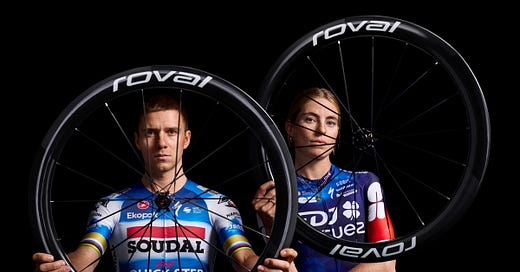Deeper front wheels: Marketing ploy or aero finally beating out tradition? ⚙️
Tech expert Andy Turner is back with another in-depth feature
Hi Subscribers,
No race content from me today. I have to head into London this afternoon, but Andy Turner has returned with another excellent and in-depth analysis on deeper front wheels!
I’ll be back tomorrow with more exclusive content and transfer news.
Have a great weekend,
Daniel 🫶
Follow me on: Twitter — Instagram — Bluesky
Specialized has caused quite a stir with the recent release of its Roval Rapide CLX Sprint Wheelset.
These wheels feature a controversial rim depth choice, with the front rim being 63mm deep and the rear being 58mm. This goes against all conventional wheelset marketing of the last few years, including Roval/Specialized itself, where rear wheels have been deeper than the front.
The previous assertion regarding wheelset design has been that to balance aerodynamics with handling, the rear wheel should be deeper, where there's no pivot point in the shape of the forks, resulting in more stability, while the front is shallower. However, this methodology goes firmly against some very well-founded aerodynamic principles.
In this article, I’m going to look at these principles and why they are not a new feature in the world of aerodynamic research or even cycling. However, I’m all for incorporating better scientific applications to improve speed, even if the UCI might be trying to slow things down.
Aero at the front makes the most difference
The understanding of aerodynamics within the cycling industry continues to advance year by year. Although we are in a position where most significant gains have been made, certain elements still prevail where tradition has taken precedence over science.
But that is changing.






